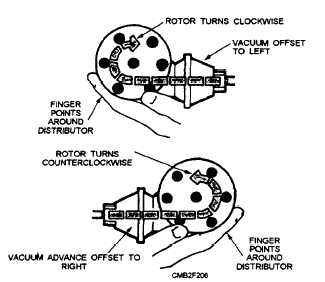The PICKUP COIL OHMETER TEST compares actual pickup resistance with the manufacturer's specifications. If the resistance is too high or low, the pickup coil is faulty. To perform this test, connect the ohmmeter across the output leads of the pickup coil. Wiggle the wire to the pickup coil and observe the meterreading. This will assist in locating any breaks in the wires to the pickup. Also, using a screwdriver, lightly tap the coil. This action will uncover any break in the coil windings.
Pickup coil resistance varies between 250 and 1,500 ohms, and you should refer to the service manual for exact specifications. Any change in the readings during the pickup coil resistance test indicates the coil should be replaced. Refer to the manufacturer's service manual for instructions for the removal and replacement of the pickup coil.
Once the pickup coil has been replaced, it will be necessary to set the PICKUP COIL AIR GAP. The air gap is the space between the pickup coil and the trigger wheel tooth. To obtain an accurate reading, use a NON- MAGNETIC FEELER GAUGE (plastic or brass).
With one tooth of the trigger wheel pointing at the pickup coil, slide the correct thickness non-magnetic feeler gauge between the trigger wheel and the pickup coil. Move the pickup coil in or out until the correct air gap is set. Tighten the pickup coil screws and double- check the air gap setting.
Ignition Timing
The ignition system must be timed so the sparks jump across the spark plug gaps at exactly the right time. Adjusting the distributor on the engine so that the spark occurs at this correct time is called setting the ignition timing. The ignition timing is normally set at idle or a speed specified by the engine manufacturer. Before measuring engine timing, disconnect and plug the vacuum advance hose going to the distributor. This action prevents the vacuum advance from functioning and upsetting the readings. Adjustment is made by loosening the distributor hold-down screw and turning the distributor in its mounting.
Turning the distributor housing against the distributor shaft rotation ADVANCES THE TIMING. Turning the distributor housing with shaft rotation RETARDS THE TIMING. Refer to figure 2-53.
When the ignition timing is TOO ADVANCED, the engine may suffer from spark knock or ping. When ignition timing is TOO RETARDED, the engine will have poor fuel economy and power and will be very

Figure 2-53. - Determining the direction of rotor rotation.
sluggish during acceleration. If extremely retarded, combustion flames blowing out of the open exhaust valve can overheat the engine and crack the exhaust manifolds.
A timing light is used to measure ignition timing. It normally has three leads - two small leads that connect to the battery-and one larger lead that connects to the NUMBER ONE spark plug wire. Depending on the type of timing light, the large lead may clip around the plug wire (inductive type), or it may need to be connected directly to the metal terminal of the plug wire (conventional type).
Draw a chalk line over the correct timing mark. This will make it easier to see. The timing marks may be either on the front cover in harmonic balance of the engine, or they may be on the engine flywheel.
With the engine running, aim the flashing timing light at the timing mark and reference pointer. The flashing timing light will make the mark appear to stand still. If the timing mark and the pointer do not line up, turn the distributor in its mounting until the timing mark and pointer are aligned. Tighten the distributor hold-down screw.
CAUTION
Keep your hands and the timing light leads from the engine fan and belts. The spinning fan and belts can damage the light or cause serious personal injury.
After the initial ignition timing, you should check to see if the automatic advance mechanism is working. This can be done by keeping the timing light flashes
Continue Reading